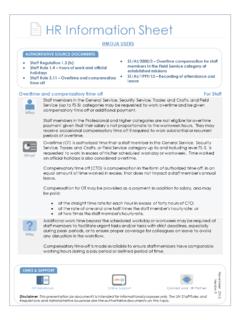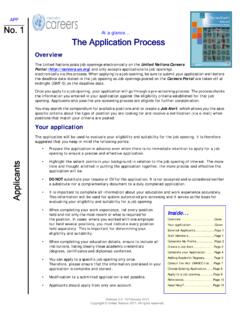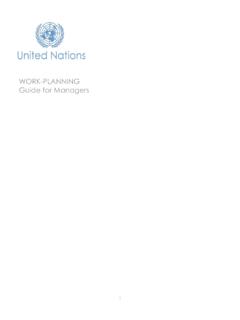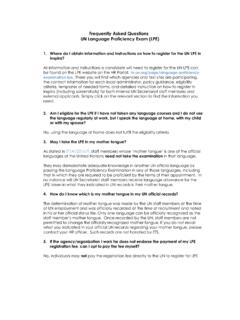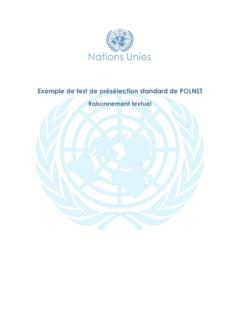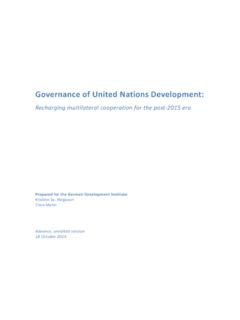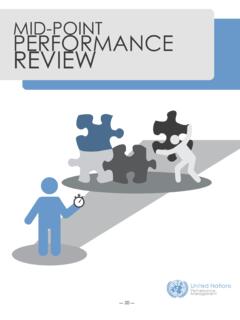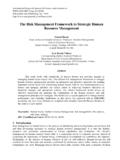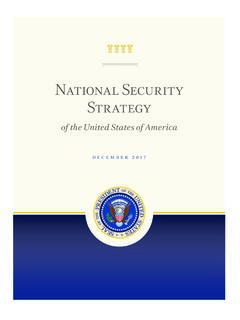Transcription of STRATEGIC PLANNING Guide for Managers
1 1 STRATEGIC PLANNING Guide for Managers 2 STRATEGIC PLANNING Basics for Managers In all UN offices, departments and missions, it is critical that Managers utilize the most effective approach toward developing a strategy for their existing programmes and when creating new programmes. Managers use the strategy to communicate the direction to staff members and Guide the larger department or office work. Here you will find practical techniques based on global management best practices. STRATEGIC PLANNING defined STRATEGIC PLANNING is a process of looking into the future and identifying trends and issues against which to align organizational priorities of the Department or Office.
2 Within the Departments and Offices, it means aligning a division, section, unit or team to a higher-level strategy. In the UN, strategy is often about achieving a goal in the most effective and efficient manner possible. For a few UN offices (and many organizations outside the UN), strategy is about achieving a mission comparatively better than another organization ( competition). For everyone, STRATEGIC PLANNING is about understanding the challenges, trends and issues; understanding who are the key beneficiaries or clients and what they need; and determining the most effective and efficient way possible to achieve the mandate. A good strategy drives focus, accountability, and results.
3 How and where to apply STRATEGIC PLANNING UN departments, offices, missions and programmes develop STRATEGIC plans to Guide the delivery of an overall mandate and direct multiple streams of work. Sub-entities create compatible strategies depending on their size and operational focus. Smaller teams within a department/office or mission may not need to create strategies; there are, however, situations in which small and medium teams may need to think strategically, in which case the following best practices can help structure the thinking. STRATEGIC plans should integrate, drive and connect to the UN budgeting process, providing the inputs to the regular budget (or programme budget ) via the STRATEGIC framework model.
4 The STRATEGIC framework , on a biennial basis, captures the objectives, expected accomplishments and indicators of achievement for each sub-programme, which would, by definition, be found in a STRATEGIC plan. STRATEGIC plans should also integrate with work- PLANNING efforts. Work-plans (also called operational plans) outline the specific, shorter-term operational objectives, outputs, projects and processes of an entity. 3 At the individual level, it is useful to adapt STRATEGIC PLANNING tools and technique to one s own job and position. Thinking and PLANNING strategically at the personal level requires similar inputs, questions, and approach, and develops your capacity to participate in PLANNING efforts for teams and higher-level entities.
5 When STRATEGIC PLANNING is done Within the UN, STRATEGIC PLANNING is undertaken in departments and offices in line with the biennial budget cycle. This PLANNING feeds into STRATEGIC framework and Programme Budget documents for each Department. You can see the overview STRATEGIC framework document for all departments here (within the UN network). The key steps for and timing of the biennial budgeting process are found in the Managers Toolkit. Other STRATEGIC plans may need to be developed outside the timeframes and parameters of the biennial budget process. For example, if an office is suddenly faced with a new challenge or mandate, a change in its operating environment, or other STRATEGIC change, it may be valuable to undertake a STRATEGIC PLANNING exercise.
6 When a new team or unit is to be established, it is imperative to develop a STRATEGIC plan at the very outset. Building a STRATEGIC Plan Element 1: External Input Gathering External Issues Scanning and Client Segmentation Analysis The first step in STRATEGIC PLANNING is to gather the information needed to understand and identify the issues, challenges and trends that will shape and affect a department, office, mission, or programme strategy. The result of such input gathering is commonly thought of as external environmental scanning. External issues refer to all factors with roots outside the entity; they do not necessarily relate to issues that come from outside the UN.
7 It is also important to gather information about the target clients ( those who are the recipients and beneficiaries of the services delivered). Such inputs help to identify and understand how to group clients, and more importantly, how to characterize their desired outcomes that would result from receiving the services. How to conduct external stakeholder and issue scanning The methods for collecting external information or issues depend on the context of the work of the unit and who it is intended to serve. Issues are generally identified through either research and/or through consultation with a number of key stakeholders. The following chart shows common lenses through which to consider collecting and analyzing information: Consider what sources of information are available to capture data and information about the issues in each category, or those most relevant to your work 4 How to conduct client segmentation analysis Clients are those who are the immediate recipients or beneficiaries of the services or products.
8 Client analysis begins with an initial step of identifying how to segment or group clients in a way that allows an entity to best align its services. There are a number of ways to segment or group clients; Managers determine the groupings that make sense in the context. For example: By demographic ( population size, age, gender, profession, etc.) By geography ( country, region, urban, rural, etc.) By entity type ( people, governments, organizations, etc.) By behaviour or condition ( injured, displaced, etc.) By internal UN structure ( other UN office) Once you have determined the groups or segments, conduct an assessment of the needs and expectations, by gathering direct input ( via surveys or focus groups) if you can.
9 In some cases, Managers may have to infer or speculate about the needs and expectations of the beneficiaries from other data that is gathered when you cannot easily access clients or stakeholders ( disaster victims). Once the client needs are known, document them by crafting statements in the first -person voice ( ) that articulates what they would say, think, or do if their needs had been met ( I believe the UN support has dramatically improved our living conditions. ). Element 2: Internal Input Gathering Internal SWOT Analysis After looking outward, the next step is to look inward to understand the issues facing an entity that may affect the strategy.
10 Consider the following: Capacity to deliver the intended services Core competencies ( what the entity is fundamentally good at doing) and business processes ( how work gets done) Staffing ( roles, skills, knowledge) Assets ( buildings and equipment) Financial resources ( budget) The most common and easy-to-use internal analysis method is the SWOT analysis. SWOT stands for Strengths, Weaknesses, Opportunities, and Threats. A SWOT analysis summarizes the perceptions of an internal constituency ( leadership and staff) regarding the internal strengths of an office, its internal weaknesses, the external opportunities for potential pursuit and the external threats to consider.
